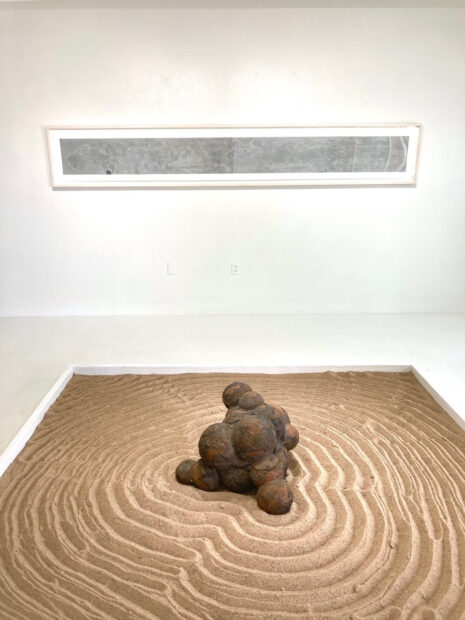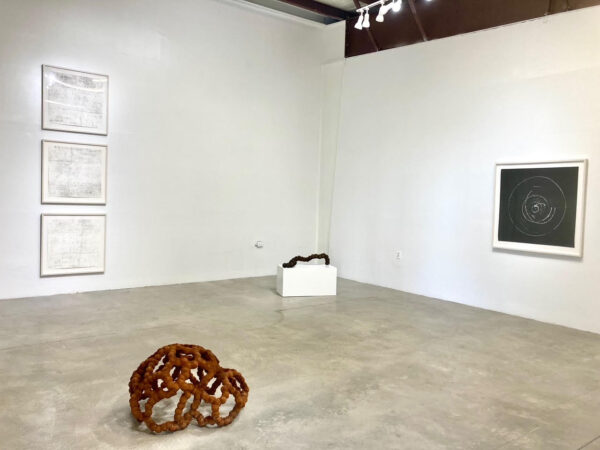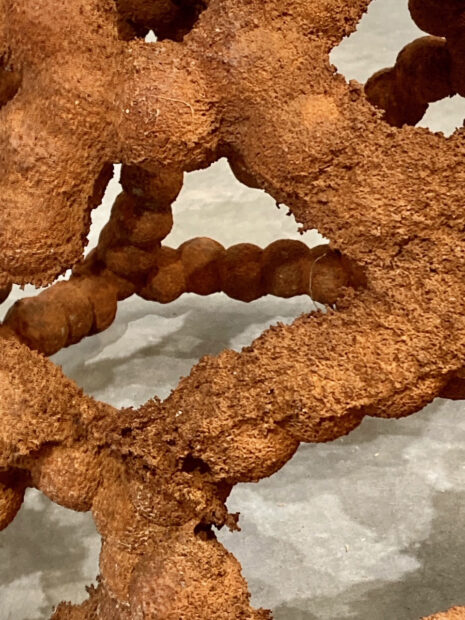
Jack Craft, “Geomorph I” and “Diamondback”, installation view in “What Was Once the Sea Is Now a Desert,” on view at the Kouri + Corrao Gallery in Santa Fe.
There are two things I remember from the first time I went hiking in Caprock Canyon State Park, just north of Quitaque in the Texas Panhandle. First, being summer, the atmosphere was scorching like a brick oven. Heat radiated in waves off brilliant treeless terra cotta-hued cliffs sculpted by epochs of erosion, and absent of any possibility of attendant shade. It was an unforgiving, albeit beguiling landscape, sublime in its equal parts of beauty and arid brutality.
The second thing that struck me, upon approaching the dramatic escarpment of the South Prong, were the two-inch bands of white gypsum that striated the walls of the dry riverbed. The presence of these deposits was jarring — in their dramatic contrast in color, their fibrous texture, and their horizontal-linear regularity within the amorphous shapes of eroded cliffs. These crystalline formations in the Caprock Escarpment speak of geological upheaval, the passage of eons; they are a remnant of an era when this desert was an ocean.
John Robert “Jack” Craft’s exhibition of new works, entitled What Was Once the Sea Is Now a Desert, at the Kouri + Corrao Gallery in Santa Fe, seems — at first glance — to reflect upon these bygone ages. But Craft’s current oeuvre, encompassing both cast-iron sculpture and printed works on paper, is more Janus-like in its articulation. These pieces are both backward- and forwarding-looking — considering, simultaneously, beginnings, transitions, and endings.
Hailing from outside Clarendon, Texas, just an hour’s drive north of the state park, and the same distance southeast of Amarillo, Craft and his family run a commercial cattle ranch in the rugged Panhandle landscape that inspires his work. The same ruddy iron that colors the Caprock Canyons is the medium with which the artist creates orb-based forms that evoke the micro (say, cellular structures, fish roe, and geodes) and the macro (planetary structures, entire worlds and continents and bodies, both celestial and marine).
Craft’s Geomorph I, for example, appears, at first blush, as a dung-heap of cast-iron spheres of varying size, dropped into sand. But upon closer inspection, the work suggests cataclysm — a collision of tiny worlds that, in a heaped mass, have crash-landed to earth. The globes’ rough patinas, resulting from exposure to the elements, conjure images of continents and oceans (so, too, does Geomorph I’s companion piece, Diamondback, an over ten-foot-long print using metallic inks). This mass of globes is situated within a Zen sand garden, which Craft himself laboriously plowed using a weighty sculpted “rake.” This performative quality adds to the layered meanings of Geomorph I, creating an alternating zooming inward and panning outward: worlds (both lost and found) and terra firma and erstwhile seas and Eastern meditation and solitude and against-all-odds agriculture that typify life on the unforgiving Llano Estacado. Creation is an arduous venture, whether it is art, or the universe, or eking out an existence on a drought-ridden land.

Jack Craft, detail of “Geomorph I,” on view in “What Was Once the Sea Is Now a Desert” at the Kouri + Corrao Gallery in Santa Fe.
Throughout the exhibition, there is an interplay of presence/absence, as with the fossil-like voids of Untitled (Inversion). Craft’s printed works conjure images of the heavenly bodies in dark skies, the spinning rotation of the cosmos, time standing still and in movement. There is, too, an almost palpable sense of loss versus gain in this exhibit, a continual balancing of the apparently unassailable calculated against relentless mutability.
The heft and solidity of Craft’s cast iron pieces evoke rigid stasis; but the very nature of his material, when left to the elements, means they are in a constant state of transformation. They are host to ever-expanding deposits of rust, scale, and hairier growth, as in Geomorph II. Like artificial coral reefs, these pieces will continue to evolve and expand with the passage of time: micro-evolutions that will, in due time, become macro. The same types of changes that render a sea a desert.

Installation view of Jack Craft’s exhibition “What Was Once the Sea Is Now a Desert,” on view at the Kouri + Corrao Gallery in Santa Fe.
What Was Once the Sea Is Now a Desert by Jack Craft is on view at the Kouri + Corrao Gallery in Santa Fe through June 17, 2023.




1 comment
Wonderful! From dung heap to cosmos. Love it.